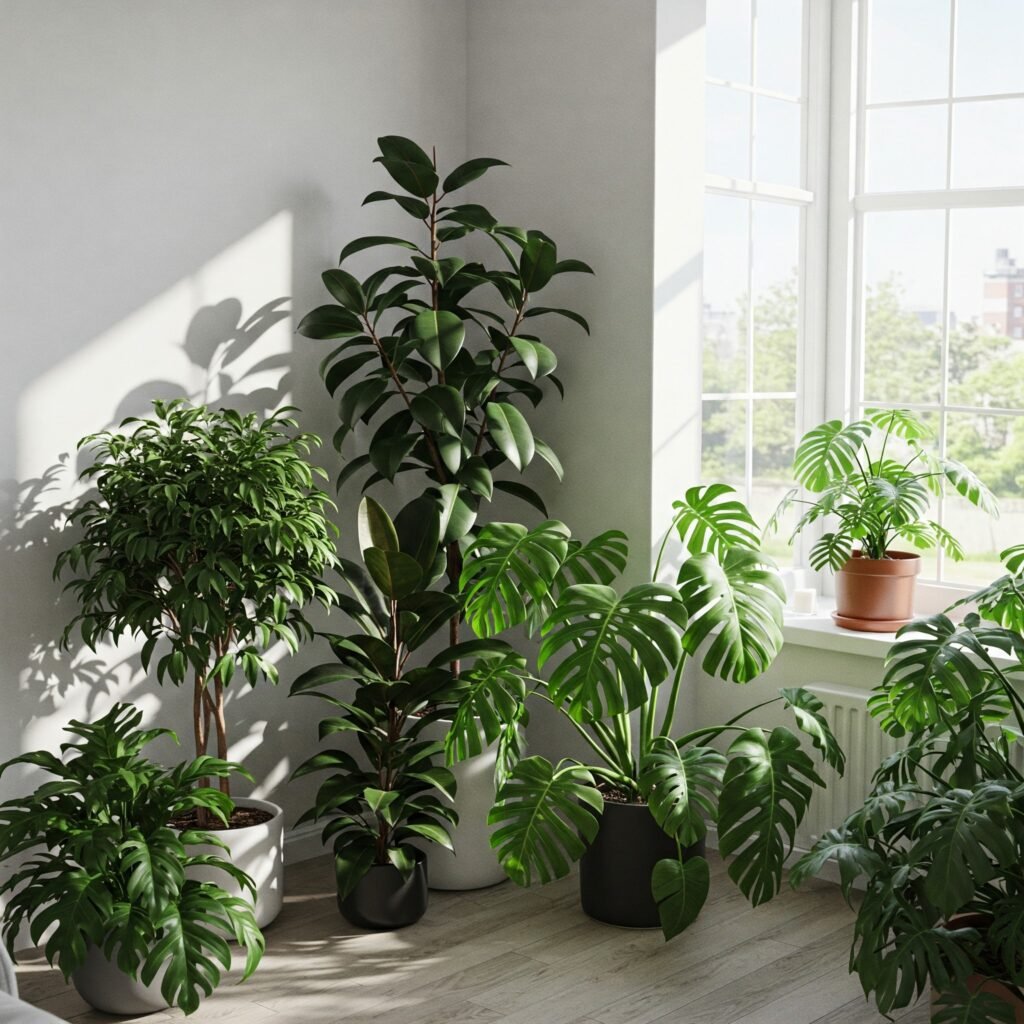Adding tall indoor plants to your home is one of the easiest ways to enhance your decor while improving air quality. These green giants bring life, texture, and a sense of tranquility to any room. Whether you have a spacious living area or a compact apartment, there’s a perfect towering plant for your space.
In this comprehensive guide, we’ll explore 15 of the best tall indoor plants, their care requirements, styling tips, and common mistakes to avoid when growing them indoors.
Benefits of Tall Indoor Plants
Tall indoor plants offer numerous benefits beyond their visual appeal:
- Space optimization: They maximize vertical space by filling empty corners and drawing the eye upward without occupying much floor space.
- Air purification: Many large varieties effectively filter indoor air pollutants like formaldehyde and benzene.
- Natural focal points: They create visual interest and anchor room designs beautifully.
- Mood enhancement: Studies show they can boost mood, reduce stress, and enhance productivity.
- Design versatility: They add texture and depth to both minimalist and maximalist interiors.
Top 15 Tall Indoor Plants
1. Fiddle Leaf Fig (Ficus lyrata)
This Instagram-favorite plant features broad, glossy leaves that add instant elegance to modern spaces.
Detailed care guide:
- Light requirements: Prefers bright, indirect sunlight (east-facing windows ideal)
- Watering schedule: Water when top 2 inches of soil are dry (about weekly)
- Humidity preferences: Benefits from occasional misting or pebble tray
- Maintenance tips: Rotate 90° weekly for even growth; wipe leaves monthly
- Growth potential: Can reach 6-10 feet indoors with proper care
2. Bird of Paradise (Strelitzia nicolai)
This dramatic tropical plant brings vacation vibes indoors with its banana-like leaves.
Comprehensive care:
- Ideal placement: Within 3-5 feet of south or west-facing windows
- Water needs: Keep soil consistently moist (water when top inch dries)
- Temperature range: Thrives in 65-80°F (18-27°C)
- Fertilizing: Monthly during growing season with balanced fertilizer
- Troubleshooting: Brown leaf tips indicate low humidity
3. Monstera Deliciosa
The Swiss Cheese Plant’s fenestrated leaves make it a favorite among interior designers.
Complete growing guide:
- Light needs: Bright, indirect light for optimal leaf splitting
- Water schedule: When top 1-2 inches of soil are dry
- Support requirements: Moss pole encourages vertical growth
- Propagation: Easily propagated through stem cuttings
- Toxicity note: Mildly toxic to pets if ingested
4. Rubber Plant (Ficus elastica)
This hardy plant offers stunning dark green or burgundy foliage with minimal fuss.
In-depth care instructions:
- Light adaptability: Does well in medium to bright indirect light
- Watering method: Allow soil to dry slightly between waterings
- Pruning technique: Cut above leaf nodes to control height
- Cleaning tips: Wipe leaves monthly with damp cloth
- Air purifying: Removes formaldehyde effectively

Seasonal Care Guide
Spring/Summer Care
- Increase watering frequency as plants grow actively
- Begin fertilizing schedule (every 2-4 weeks)
- Ideal time for repotting if needed
- Watch for pest outbreaks
Fall/Winter Care
- Reduce watering as growth slows
- Discontinue fertilizing
- Move plants away from cold drafts
- Consider supplemental lighting
Troubleshooting Common Problems
Yellowing Leaves
- Overwatering: Check soil moisture before watering
- Nutrient deficiency: Try balanced fertilizer
- Poor drainage: Ensure pot has drainage holes
Brown Leaf Tips
- Low humidity: Mist leaves or use humidifier
- Chemical sensitivity: Use filtered water
- Salt buildup: Flush soil occasionally
Pest Control
- Spider mites: Wipe with soapy water
- Mealybugs: Use rubbing alcohol on cotton swab
- Scale: Neem oil treatment
Pet Safety Considerations
Pet-Friendly Options:
- Areca Palm
- Parlor Palm
- Banana Plant
Toxic Varieties (keep away from pets):
- Fiddle Leaf Fig
- Dracaena
- ZZ Plant
Styling Ideas by Room
Living Room
- Use statement plants like Bird of Paradise as focal points
- Flank sofas with matching Fiddle Leaf Figs
- Create height variation with plant stands
Bedroom
- Choose air-purifying varieties like Snake Plant
- Opt for low-maintenance options like ZZ Plant
- Avoid overly fragrant plants
Home Office
- Select plants that boost focus like Rubber Plant
- Use narrow varieties for small spaces
- Consider trailing plants for shelves
Final Thoughts
Tall indoor plants offer countless benefits for both your living space and wellbeing. By selecting the right varieties for your conditions and following proper care techniques, you can enjoy lush, healthy plants that transform your home’s atmosphere.
Remember to:
- Match plants to your light conditions
- Establish a consistent care routine
- Monitor for early signs of stress
- Adjust care with seasonal changes
- Enjoy the process of plant parenthood
What tall plants have you had success with? Share your experiences and questions in the comments below!
